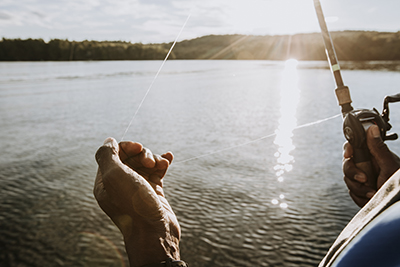Home → Fish & Wildlife → Fisheries → Developing Fishing Regulations
Developing Fishing Regulations

Learn how fishing regulations are developed and how you, the public, can be involved
Conserving and enhancing native and wild fish populations, including the wise public use of this renewable resource, remains an important focus of MDIFW, and regulations are one of the tools we use to support that priority. We develop fishing regulations based upon fishery science principles, incorporating biological assessments, chemical and physical habitat characteristics, and public use, and they are commonly designed to protect spawning fish, encourage fish recruitment, manage harvest sustainably, improve fish health and size quality, provide a diversity of fishing opportunities, and manage invasive threats.
Regulation Setting Process
The Fisheries and Hatcheries Division develops, implements, reviews, and updates fishing regulations to achieve management objectives consistent with water-specific management plans, statewide strategic plans, and public interests. Regulatory needs are typically evaluated each year and draft regulation proposals, including statewide initiatives and special focus areas, are developed within each management region with direction from Division leadership. The process of Division regulation promulgation can be divided into four distinct sub-processes: drafting, internal review, external/public review, and implementation. In addition to the Division-initiated process, regulation proposals can also be developed via public petition.
Part 1: Drafting
The Division typically formulates rule changes after evaluating data for a given fishery that suggest current regulations are not meeting management goals. It’s not uncommon for data collection and evaluation to occur in response to public concerns expressed to regional staff. Other proposals are prompted by regulatory concerns including law book simplification and statewide language consistency. Prior to formal public review, all rule change proposals are documented as internal drafts for future vetting by MDIFW staff. Each of these preliminary/draft proposals contains several sections describing the rule change, including:
- Management goals and objectives for the waterbody
- Current and proposed regulations
- A statement of need
- A summary of any outreach conducted prior to drafting the official rule-making proposal
- A list of alternative management strategies that were explored in addition to the proposed rule change
Part 2: Internal Review
When Fisheries Resource Supervisors submit a proposal, it is first reviewed by the Fisheries Division Director and Fisheries Management Section Supervisor to ensure it has merit, is consistent with established direction and initiatives, and aligns with the Division’s policies and plans. Proposals are then presented to and reviewed by all other Fisheries Resource Supervisors and Division leadership at an annual in-house meeting. This review considers available data, alternative strategies, outreach and public involvement, potential unintended consequences, and the overall need and value of each regulation given the Division’s goal to reduce law book complexity. During the meeting, staff commonly share their experiences with similar management challenges and regulations; and afterward, Resource Supervisors may modify proposals based on peer input or direction from the Management Section Supervisor before sending them to the Division Director for another round of review. The Director and Management Section Supervisor then meet with the Bureau Director and the Commissioner’s office to give them an overview of all the proposals.
Following that meeting, proposals are finalized and prepared for advertisement as a formal rule-making packet open to public comment. The rest of the rule-making process is dictated by the Maine Administrative Procedures Act, which ensures all state agencies follow a consistent and comprehensive procedure.
Part 3: External/Public Review
Proposals, whether initiated by the Division or public petition, are brought forward to the MDIFW Advisory Council for an initial briefing. The council consists of 10 individuals appointed by the Governor to represent all of Maine’s 16 counties (some represent multiple counties). This introduction of the proposed rule changes, referred to as Step 1, allows the council to become oriented to the rules packet and ask any initial questions. Staff may give presentations at this step to provide background on proposals that are more complex or more likely to generate public interest. By Step 2 of the process, a Notice of Rulemaking Proposal is published in all major printed news sources in Maine and on the MDIFW website to notify the public of the proposed change and upcoming public hearings. Each rulemaking proposal is open to public comment for 30 days, with comments accepted via email, letter, or in person at one or more of the public hearings that are typically scheduled. At the Step 2 council meeting, the Department provides council members with a summary of all the public input. The council may discuss the public input and ask questions of the Department. At Step 3 the Department provides the council with an overview of the process to date and any considerations that may result in removal of rule proposals from the original packet. The council can then deliberate before voting on the rule packet. This vote constitutes a recommendation to the Commissioner to either approve or deny the entire rule packet.
Part 4: Implementation
The approved rule packet is typically implemented on January 1 of the following year, with the council vote occurring in late summer or early fall. This gives MDIFW staff time to incorporate changes into the law book and the online regulation mapper (FLOAT). Aside from rare emergency changes, annual fishing regulations are effective January 1–December 31.